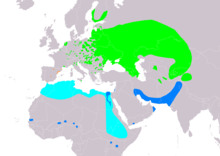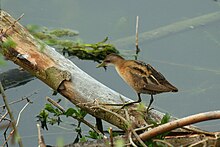Little Moorhen
| Little Moorhen | ||||||||||
|---|---|---|---|---|---|---|---|---|---|---|

Little Moorhen ( Porzana parva ) |
||||||||||
| Systematics | ||||||||||
|
||||||||||
| Scientific name | ||||||||||
| Porzana parva | ||||||||||
| ( Scopoli , 1769) |
The little moorhen ( Porzana parva ), also known as the little rail , is a species of bird from the genus of the moorhens ( Porzana ) in the family of the railing (Rallidae) native to Eurasia . In the east of Central Europe , the little moorhen is a common breeding and summer bird. In Germany , the Netherlands , Switzerland and the Czech Republic , on the other hand, there are only locally isolated breeding occurrences.
features
The little moorhen becomes 18 to 20 centimeters long and has a wingspan of 34 to 39 centimeters. The male weighs 30 to 72 grams, the female 36 to 65 grams. This makes it one of the smallest indigenous rail species, together with the dwarf moose. The little moorhen can live up to six years. The brown plumage above has black and white markings.
Below it is blue-gray in the male with weak banding of the flanks, in the female it is brownish. The little moorhen differs from the similar dwarf moorhen by greenish and not brownish-pink legs, an olive-green beak with a red spot on the base and the lack of black banding on the flanks.
Occurrence
The little marsh grouse occurs from Eastern Europe to Western Siberia, in Central Europe it is only common in the east and southeast. The main distribution area of the little moorhen are the lowlands of the western Palearctic . The height distribution extends up to about 430 meters. The main areas of distribution are the steppe areas of Eastern Europe. In the north the species occurs up to the border of the forest steppe zone. In the south the distribution area extends to the transition to the semi-deserts. In Central Europe, the distribution is mainly limited to the lowlands of Poland and northeastern Germany and the area of the so-called Pannonian basin . There are also isolated occurrences further to the west and south-west. The little moorhen is a migratory bird and winters in south-western Europe , the Mediterranean region and in East and North Africa . It moves away in October and comes back in March.
The little moorhen lives in swampy, dense silting areas such as belts of reeds, reeds and rushes. It prefers tall, perennial and structurally rich reed beds that have at least small adjacent open water areas or are adjacent to pools, ditches or channels. But it also occurs in mixed stands with bulrushes or large harrows. Since it can also swim, it inhabits reeds that are deeper in the water than other moorhens.
nutrition
The little moorhen eats invertebrates and their larvae, tender plant material and seeds from aquatic plants.
Reproduction
The nest is a thick nest platform made of rushes, sedges, etc., which is laid out with finer plant material. The nest is well camouflaged from above due to the contracted stalks.
Once or twice a year, from May to June and from June to July, four to eight yellowish, brown-spotted, 29 mm eggs are laid, which are incubated by both parents for 21-23 days. After hatching, the chicks stay in the nest for up to eight days and learn to fly at around 50 days.
behavior
The little moorhen is diurnal and shows up mainly in the morning and in the evening. The male sings mainly in the twilight. The call consists of "gak" or "quäck". The unmated female has her own calls like "pöck pöek pöck" or "kikerr".
Duration
The little moorhen is classified as "endangered" (category 3) on the red list of Germany's breeding birds. It is a species of Appendix I of the EU Bird Protection Directive (RL 79/409 / EEC). The total European population is estimated at around 61,000 to 140,000 breeding pairs at the beginning of the 21st century. The largest European populations are found in Austria (12,000 to 22,000 pairs), the Ukraine (26,000 to 43,000 pairs) and Russia (10,000 to 50,000 breeding pairs). The Central European population is at least 16,000 to 30,000 breeding pairs.
The little moorhen is one of the species suspected of having a particularly strong impact of global warming. A research team that, on behalf of the British environmental authority and the RSPB, examined the future development of the distribution of European breeding birds on the basis of climate models assumes that the range will be significantly more fragmented by the end of the 21st century. According to these forecasts, most of the breeding areas in south-east Europe will no longer offer suitable habitats for the little moorhen. The loss of area is not compensated for by newly suitable habitats in the south of Fennos Scandinavia .
supporting documents
literature
- Hans-Günther Bauer, Einhard Bezzel and Wolfgang Fiedler (eds.): The compendium of birds in Central Europe: Everything about biology, endangerment and protection. Volume 1: Nonpasseriformes - non-sparrow birds. Aula-Verlag Wiebelsheim, Wiesbaden 2005, ISBN 3-89104-647-2 .
Individual evidence
- ↑ Bauer et al., P. 398 and p. 399
- ↑ Martin Flade: The breeding bird communities of Central and Northern Germany - Basics for the use of ornithological data in landscape planning . IHW-Verlag, Berlin 1994, ISBN 3-930167-00-X , p. 554
- ↑ Christoph Grüneberg, Hans-Günther Bauer, Heiko Haupt, Ommo Hüppop, Torsten Ryslavy & Peter Südbeck: Red List of Germany's Breeding Birds , 5th version, November 30, 2015 . In: Reports on bird protection . tape 52 , 2015, p. 19-67 .
- ↑ Bauer et al., P. 399
- ^ Brian Huntley, Rhys E. Green, Yvonne C. Collingham, Stephen G. Willis: A Climatic Atlas of European Breeding Birds , Durham University, The RSPB and Lynx Editions, Barcelona 2007, ISBN 978-84-96553-14-9 , P. 153
Web links
- Zapornia parva in the endangered Red List species the IUCN 2008. Posted by: BirdLife International, 2008. Accessed January 30 of 2009.
- Videos, photos and sound recordings for Porzana parva in the Internet Bird Collection
- Little mock feathers


